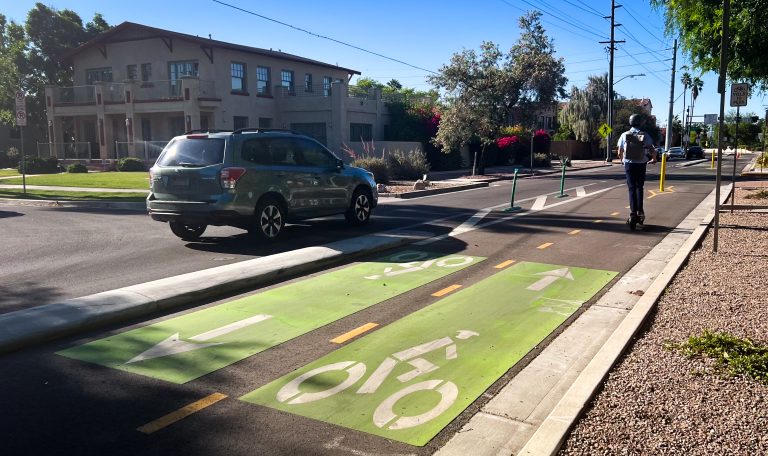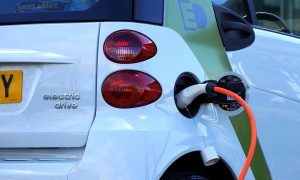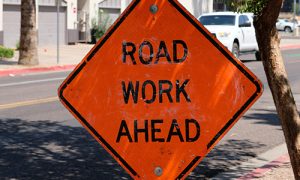Six miles. According to the U.S. Department of Transportation, that’s the distance of the average American car trip. During rush hour in a major city like Phoenix, driving six miles along city streets could take about 25 minutes; the average gasoline-powered car would emit about 1.2 kilograms of carbon dioxide and cost the driver about $1.04 in fuel.
On an electric bike, that same trip would take about the same amount of time – but thanks to the City of Phoenix cycling infrastructure, a cyclist could skip most of the bumper-to-bumper traffic as they rode along bikeways built through quiet neighborhoods. Most importantly, though, the cyclist would pay about two cents for the electricity required and emit essentially zero carbon dioxide.
Communities seeking to reduce carbon emissions from fossil-fuel-powered vehicles are facing a dilemma: full-scale adoption of electric vehicles will likely remain impractical for many years, but the longer they delay action the more challenging the transition could be. To bridge the gap, local governments are trying to expand access to small, lightweight electric vehicles like electric bikes (e-bikes) and scooters, as well as investing in what transportation experts call “micromobility infrastructure” that simultaneously encourages these vehicles and discourages traditional auto use.
Micromobility incentives
E-bikes and e-scooters can come with a high startup cost. The least expensive e-bike sold by Lectric e-Bikes sells for about $799; e-scooter blogs suggest that about $750 is the “sweet spot” for a good quality e-scooter. To stimulate growth, some local and state governments are offering incentives to expand micromobility options in their communities.
Proponents say the incentives are a cost-effective way to encourage micromobility and reduce car dependence. The City of Denver’s e-bike incentive program managed to put 4,700 electric bikes on the streets in 2022. Based on data collected from e-bike users, the program reduced CO2 emissions by little under one pound of carbon dioxide per dollar spent – a total of 2,040 metric tons in reduced emissions that year.
As of early 2024, five states and dozens of cities have either proposed or implemented similar e-bike incentive programs. Most of these programs offer rebates or tax credits for residents who purchase an e-bike, and are tiered based on income or have other eligibility requirements.
Infrastructure investments
Perhaps the largest barrier to the widespread adoption of micromobility is the sheer lack of cycling infrastructure in American cities. In a 2023 study, more than 60% of bicycle owners said the one thing stopping them from riding is having to ride on a road with motor vehicles. In most cities, bicycle infrastructure is little more than a painted line along the side of a road – but more communities are investing in infrastructure that prioritizes micromobility.
In 2023, the U.S. Dept. of Transportation awarded more than $813 million in grants under the Safe Streets for All program. These grants allow local governments to expand pedestrian infrastructure and develop safe bicycle corridors in cities. For example, the city of Dearborn, Michigan was awarded nearly $25 million to narrow a five-lane road into a multi-modal thoroughfare with protected bike lanes that are separated from traffic.
These investments are not without critics and detractors. In Arizona, Republicans in the state Senate introduced a bill that tied funding for the state’s transportation department to several prohibitions that could impede the expansion of micromobility initiatives in the state. The bill banned the state from funding – or accepting any outside funding for – electric vehicle infrastructure, passenger rail, non-bus mass transit, or developing any so-called “carbon reduction plans.” The bill passed the Arizona Senate but died in the state House.










